MOFs-Modified Electrochemical Sensors and the Application in the Detection of Opioids
Abstract
1. Introduction
2. MOFs Materials
2.1. Classification of MOFs
2.2. MOFs Composites
2.2.1. MOFs-Carbon
2.2.2. MOFs-Metal Nanoparticles
2.2.3. MOFs-Metal Compounds
2.2.4. MOFs-Polymers
3. MOFs-Based Electrochemical Sensors
3.1. Construction of MOFs-Based Electrochemical Sensors
3.2. Microfluidic Chips in MOFs-Based Electrochemical Sensors
4. Application of MOFs-Based Electrochemical Sensors for Opioid Concentration Detection
5. Conclusions
Author Contributions
Funding
Institutional Review Board Statement
Informed Consent Statement
Data Availability Statement
Conflicts of Interest
References
- Yong, R.J.; Mullins, P.M.; Bhattacharyya, N. Prevalence of Chronic Pain among Adults in the United States. Pain 2021, 163, e328–e332. [Google Scholar] [CrossRef] [PubMed]
- Dahlhamer, J.; Lucas, J.; Zelaya, C.; Nahin, R.; Mackey, S.; DeBar, L.; Kerns, R.; Korff, M.V.; Porter, L.; Helmick, C. Prevalence of Chronic Pain and High-Impact Chronic Pain among Adults—United States, 2016. MMWR Morb. Mortal. Wkly. Rep. 2018, 67, 1001–1006. [Google Scholar] [CrossRef] [PubMed]
- Cordier Scott, L.; Lewis, S. JAMA Patient Page: Opioids for Chronic Pain. JAMA 2016, 315, 1672. [Google Scholar] [CrossRef] [PubMed]
- Jayawardana, S.; Forman, R.; Johnston-Webber, C.; Campbell, A.; Berterame, S.; Joncheere, C.d.; Aitken, M.; Mossialos, E. Global Consumption of Prescription Opioid Analgesics between 2009-2019: A Country-Level Observational Study. eClinicalMedicine 2021, 42, 101198. [Google Scholar] [CrossRef]
- Kroning, K.E.; Li, M.; Petrescu, D.I.; Wang, W. A Genetically Encoded Sensor with Improved Fluorescence Intensity for Opioid Detection at Cellular Resolution. Chem. Commun. 2021, 57, 10560–10563. [Google Scholar] [CrossRef]
- Farahani, A.; Azimi, S.; Azimi, M. Developing an Integrated POC Spectrophotometric Device for Discrimination and Determination of Opioids Based on Gold Nanoparticles. Microchem. J. 2022, 182, 107930. [Google Scholar] [CrossRef]
- Valdez, C.A. Gas Chromatography-Mass Spectrometry Analysis of Synthetic Opioids Belonging to the Fentanyl Class: A Review. Crit. Rev. Anal. Chem. 2021, 52, 1938–1968. [Google Scholar] [CrossRef]
- Haddad, A.; Comanescu, M.A.; Green, O.; Kubic, T.A.; Lombardi, J.R. Detection and Quantitation of Trace Fentanyl in Heroin by Surface-Enhanced Raman Spectroscopy. Anal. Chem. 2018, 90, 12678–12685. [Google Scholar] [CrossRef]
- Muñoz-Muñoz, A.C.; Pekol, T.; Schubring, D.; Johnson, C.; Andrade, L. Identification of Novel Opioid Interferences Using High-Resolution Mass Spectrometry. J. Anal. Toxicol. 2017, 42, 6–16. [Google Scholar] [CrossRef]
- Li, L.; Yu, X.; Lyu, L.; Duan, H.; Chen, Y.; Bian, J.; Xu, Z.; Liu, L.; Zhang, Y. Determination of Fentanyl, Alpha-Methylfentanyl, Beta-Hydroxyfentanyl and the Metabolite Norfentanyl in Rat Urine by LC–MS-MS. J. Anal. Toxicol. 2022, 46, 421–431. [Google Scholar] [CrossRef]
- Bahrami, G.; Ehzari, H.; Mirzabeigy, S.; Mohammadi, B.; Arkan, E. Fabrication of a Sensitive Electrochemical Sensor Based on Electrospun Magnetic Nanofibers for Morphine Analysis in Biological Samples. Mater. Sci. Eng. C 2020, 106, 110183. [Google Scholar] [CrossRef]
- Khosropour, H.; Rezaei, B.; Alinajafi, H.A.; Ensafi, A.A. Electrochemical Sensor Based on Glassy Carbon Electrode Modified by Polymelamine Formaldehyde/Graphene Oxide Nanocomposite for Ultrasensitive Detection of Oxycodone. Microchim. Acta 2021, 188, 1. [Google Scholar] [CrossRef]
- Rajaei, M.; Foroughi, M.M.; Jahani, S.; Shahidi Zandi, M.; Hassani Nadiki, H. Sensitive Detection of Morphine in the Presence of Dopamine with La3+ Doped Fern-like CuO Nanoleaves/MWCNTs Modified Carbon Paste Electrode. J. Mol. Liq. 2019, 284, 462–472. [Google Scholar] [CrossRef]
- Bagherinasab, Z.; Beitollahi, H.; Yousefi, M.; Bagherzadeh, M.; Hekmati, M. A Sensitive Voltammetric Morphine Nanosensor Based on BaFe12O19 Nanoparticle-Modified Screen-Printed Electrodes. J. Iran. Chem. Soc. 2020, 17, 717–724. [Google Scholar] [CrossRef]
- Abraham, P.; Renjini, S.; Vijayan, P.; Nisha, V.; Sreevalsan, K.; Anithakumary, V. Review—Review on the Progress in Electrochemical Detection of Morphine Based on Different Modified Electrodes. J. Electrochem. Soc. 2020, 167, 037559. [Google Scholar] [CrossRef]
- Wang, L.; Saji, S.E.; Wu, L.; Wang, Z.; Chen, Z.; Du, Y.; Yu, X.; Zhao, H.; Yin, Z. Emerging Synthesis Strategies of 2D MOFs for Electrical Devices and Integrated Circuits. Small 2022, 18, 2201642. [Google Scholar] [CrossRef]
- Liu, Z.; Bai, J.; Liang, C.; Wang, Y.; Nie, H.; Liu, X.; Yan, H. Sensitive Fluorescent Biosensor Based on a Europium-Based Metal-Organic Framework for Protein Kinase Activity Analysis. Biosens. Bioelectron. 2022, 203, 114055. [Google Scholar] [CrossRef]
- Chen, Z.; Mian, M.R.; Lee, S.J.; Chen, H.; Zhang, X.; Kirlikovali, K.O.; Shulda, S.; Melix, P.; Rosen, A.S.; Parilla, P.A.; et al. Fine-Tuning a Robust Metal–Organic Framework toward Enhanced Clean Energy Gas Storage. J. Am. Chem. Soc. 2021, 143, 18838–18843. [Google Scholar] [CrossRef]
- Wang, Y.; Jin, H.; Ma, Q.; Mo, K.; Mao, H.; Feldhoff, A.; Cao, X.; Li, Y.; Pan, F.; Jiang, Z. A MOF Glass Membrane for Gas Separation. Angew. Chem. Int. Ed. 2020, 59, 4365–4369. [Google Scholar] [CrossRef]
- Xu, W.; Wang, L.H.; Chen, Y.; Liu, Y. Flexible Carbon Membrane Supercapacitor Based on γ-Cyclodextrin-MOF. Mater. Today Chem. 2022, 24, 100896. [Google Scholar] [CrossRef]
- Suresh, K.; Matzger, A.J. Enhanced Drug Delivery by Dissolution of Amorphous Drug Encapsulated in a Water Unstable Metal–Organic Framework (MOF). Angew. Chem. Int. Ed. 2019, 58, 16790–16794. [Google Scholar] [CrossRef] [PubMed]
- Yuan, Y.; Yu, J.; Chen, H.; Bang, K.T.; Pan, D.; Kim, Y. Thiol-Functionalized Zr Metal-Organic Frameworks for Efficient Removal of Fe3+ from Water. Cell Rep. Phys. Sci. 2022, 3, 100783. [Google Scholar] [CrossRef]
- Yaghi, O.M.; Li, G.; Li, H. Selective Binding and Removal of Guests in a Microporous Metal–Organic Framework. Nature 1995, 378, 703–706. [Google Scholar] [CrossRef]
- Chen, T.; Dou, J.H.; Yang, L.; Sun, C.; Oppenheim, J.J.; Li, J.; Dincă, M. Dimensionality Modulates Electrical Conductivity in Compositionally Constant One-, Two-, and Three-Dimensional Frameworks. J. Am. Chem. Soc. 2022, 144, 5583–5593. [Google Scholar] [CrossRef] [PubMed]
- Yu, B.; Ye, G.; Zeng, Z.; Zhang, L.; Chen, J.; Ma, S. Mussel-Inspired Polydopamine Chemistry to Modulate Template Synthesis of 1D Metal–Organic Framework Superstructures. J. Mater. Chem. A 2018, 6, 21567–21576. [Google Scholar] [CrossRef]
- Li, H.; Hou, J.; Bennett, T.D.; Liu, J.; Zhang, Y. Templated Growth of Vertically Aligned 2D Metal–Organic Framework Nanosheets. J. Mater. Chem. A 2019, 7, 5811–5818. [Google Scholar] [CrossRef]
- Liu, X.; An, L.; Xiang, S.; Jiang, H.; Cheng, G.J. 3D MOF Nanoarchitecture Membrane via Ultrafast Laser Nanoforging. Small Methods 2021, 5, 2100758. [Google Scholar] [CrossRef]
- Eddaoudi, M.; Kim, J.; Rosi, N.; Vodak, D.; Wachter, J.; O’Keeffe, M.; Yaghi, O.M. Systematic Design of Pore Size and Functionality in Isoreticular MOFs and Their Application in Methane Storage. Science 2002, 295, 469–472. [Google Scholar] [CrossRef]
- Park, K.S.; Ni, Z.; Côté, A.P.; Choi, J.Y.; Huang, R.; Uribe-Romo, F.J.; Chae, H.K.; O’Keeffe, M.; Yaghi, O.M. Exceptional Chemical and Thermal Stability of Zeolitic Imidazolate Frameworks. Proc. Natl. Acad. Sci. 2006, 103, 10186–10191. [Google Scholar] [CrossRef]
- Férey, G.; Serre, C.; Mellot-Draznieks, C.; Millange, F.; Surblé, S.; Dutour, J.; Margiolaki, I. A Hybrid Solid with Giant Pores Prepared by a Combination of Targeted Chemistry, Simulation, and Powder Diffraction. Angew. Chem. 2004, 116, 6456–6461. [Google Scholar] [CrossRef]
- Janiak, C.; Vieth, J.K. Mofs, MILs and More: Concepts, Properties and Applications for Porous Coordination Networks (PCNs). New J. Chem. 2010, 34, 2366. [Google Scholar] [CrossRef]
- Bunzen, H.; Javed, A.; Klawinski, D.; Lamp, A.; Grzywa, M.; Kalytta-Mewes, A.; Tiemann, M.; von Nidda, H.A.K.; Wagner, T.; Volkmer, D. Anisotropic Water-Mediated Proton Conductivity in Large Iron(II) Metal–Organic Framework Single Crystals for Proton-Exchange Membrane Fuel Cells. ACS Appl. Nano Mater. 2018, 2, 291–298. [Google Scholar] [CrossRef]
- Lan, B.L.; Shao, B.; Yang, F.J.; Pang, W.; Guo, Z.; Meng, T.; Zhang, Z.; Huang, J. Metal-Organic Frameworks-Derived Nickel–Iron Oxyhydroxide with Highly Active Edge Sites for Electrochemical Oxygen Evolution. Small Struct. 2022, 3, 2200085. [Google Scholar] [CrossRef]
- Li, M.Y.; Wang, F.; Zhang, J. Synthesis, Structure and Proton Conductivity of a Metal–Organic Framework with Rich Hydrogen-Bonds between the Layers. Inorg. Chem. Commun. 2017, 79, 37–40. [Google Scholar] [CrossRef]
- Casey, K.C.; Appiah, J.K.; Robinson, J.R. Low-Symmetry β-Diketimine Aryloxide Rare-Earth Complexes: Flexible, Reactive, and Selective. Inorg. Chem. 2020, 59, 14827–14837. [Google Scholar] [CrossRef]
- Misra, R.; Saseendran, A.; Dey, S.; Gopi, H.N. Metal-Helix Frameworks from Short Hybrid Peptide Foldamers. Angew. Chem. Int. Ed. 2019, 58, 2251–2255. [Google Scholar] [CrossRef]
- Thakkar, J.; Guo, W.K.; Janik, M.J.; Zhang, X. Selective Adsorption of Butenes over Butanes on Isoreticular Ni-IRMOF-74-I and Ni-IRMOF-74-II. RSC Adv. 2022, 12, 20599–20602. [Google Scholar] [CrossRef]
- Stavila, V.; Foster, M.E.; Brown, J.W.; Davis, R.W.; Edgington, J.; Benin, A.I.; Zarkesh, R.A.; Parthasarathi, R.; Hoyt, D.W.; Walter, E.D.; et al. IRMOF-74(n)-Mg: A Novel Catalyst Series for Hydrogen Activation and Hydrogenolysis of C–O Bonds. Chem. Sci. 2019, 10, 9880–9892. [Google Scholar] [CrossRef]
- Li, T.C.; Kong, X.J.; Xie, Y.; He, T.; Si, G.R.; Li, X.Y.; Wu, W.; Zhao, M.; Li, J.R. Metalloporphyrin Functionalized Multivariate IRMOF-74-IV Analogs for Photocatalytic CO2 Reduction. Sep. Purif. Technol. 2022, 292, 121080. [Google Scholar] [CrossRef]
- Cai, M.; Liang, W.; Wang, K.; Yin, D.; Fu, T.; Zhu, R.; Qu, C.; Dong, X.; Ni, J.; Yin, X. Aperture Modulation of Isoreticular Metal Organic Frameworks for Targeted Antitumor Drug Delivery. ACS Appl. Mater. Interfaces 2022, 14, 36366–36378. [Google Scholar] [CrossRef]
- Miliutina, E.; Guselnikova, O.; Chufistova, S.; Kolska, Z.; Elashnikov, R.; Burtsev, V.; Postnikov, P.; Svorcik, V.; Lyutakov, O. Fast and All-Optical Hydrogen Sensor Based on Gold-Coated Optical Fiber Functionalized with Metal–Organic Framework Layer. ACS Sens. 2019, 4, 3133–3140. [Google Scholar] [CrossRef] [PubMed]
- Shao, Y.; Tian, M.; Zhen, Z.; Cui, J.; Xiao, M.; Qi, B.; Wang, T.; Hou, X. Adsorption of Ag/Au Nanoparticles by Ordered Macro-Microporous ZIF-67, and Their Synergistic Catalysis Application. J. Clean. Prod. 2022, 346, 131032. [Google Scholar] [CrossRef]
- Gorky, F.; Lucero, J.M.; Crawford, J.M.; Blake, B.; Carreon, M.A.; Carreon, M.L. Plasma-Induced Catalytic Conversion of Nitrogen and Hydrogen to Ammonia over Zeolitic Imidazolate Frameworks ZIF-8 and ZIF-67. ACS Appl. Mater. Interfaces 2021, 13, 21338–21348. [Google Scholar] [CrossRef] [PubMed]
- Ebrahimi, Z.; Rad, M.; Safarifard, V.; Moradi, M. Solvent-Assisted Ligand Exchange as a Post-Synthetic Surface Modification Approach of Zn-Based (ZIF-7, ZIF-8) and Co-Based (ZIF-9, ZIF-67) Zeolitic Frameworks for Energy Storage Application. J. Mol. Liq. 2022, 364, 120018. [Google Scholar] [CrossRef]
- Chu, H.; Shen, J.; Wang, C.; Wei, Y. Biodegradable Iron-Doped ZIF-8 Based Nanotherapeutic System with Synergistic Chemodynamic/Photothermal/Chemo-Therapy. Colloids Surf. Physicochem. Eng. Asp. 2021, 628, 127388. [Google Scholar] [CrossRef]
- Ma, H.; Yang, Y.; Yin, F.; Zhang, X.F.; Qiu, J.; Yao, J. Integration of Thermoresponsive MIL-121 into Alginate Beads for Efficient Heavy Metal Ion Removal. J. Clean. Prod. 2022, 333, 130229. [Google Scholar] [CrossRef]
- Remiro-Buenamañana, S.; Cabrero-Antonino, M.; Martínez-Guanter, M.; Álvaro, M.; Navalón, S.; García, H. Influence of Co-Catalysts on the Photocatalytic Activity of MIL-125(Ti)-NH2 in the Overall Water Splitting. Appl. Catal. B Environ. 2019, 254, 677–684. [Google Scholar] [CrossRef]
- Tan, X.; Zhang, J.; Shi, J.; Cheng, X.; Tan, D.; Zhang, B.; Liu, L.; Zhang, F.; Han, B.; Zheng, L. Fabrication of NH 2 -MIL-125 Nanocrystals for High Performance Photocatalytic Oxidation. Sustain. Energy Fuels 2020, 4, 2823–2830. [Google Scholar] [CrossRef]
- Yodsin, N.; Sriphumrat, K.; Mano, P.; Kongpatpanich, K.; Namuangruk, S. Metal-Organic Framework MIL-100(Fe) as a Promising Sensor for COVID-19 Biomarkers Detection. Microporous Mesoporous Mater. 2022, 343, 112187. [Google Scholar] [CrossRef]
- Iacomi, P.; Gulcay-Ozcan, E.; Conti, P.P.; Biswas, S.; Steunou, N.; Maurin, G.; Rioland, G.; Devautour-Vinot, S. MIL-101(Cr) MOF as an Effective Siloxane Sensor. ACS Appl. Mater. Interfaces 2022, 14, 17531–17538. [Google Scholar] [CrossRef]
- Lin, X.; Dong, Y.; Chen, X.; Liu, H.; Liu, Z.; Xing, T.; Li, A.; Song, H. Metallasilsesquioxane-Derived Ultrathin Porous Carbon Nanosheet 3D Architectures via an “in Situ Dual Templating” Strategy for Ultrafast Sodium Storage. J. Mater. Chem. A 2021, 9, 6423–6431. [Google Scholar] [CrossRef]
- Zhu, L.; Wang, Y.; Wang, M.; Huang, M.; Huang, Y.; Zhang, Z.; Yu, J.; Qu, Y.; Li, C.; Yang, Z. High Edge-Nitrogen-Doped Porous Carbon Nanosheets with Rapid Pseudocapacitive Mechanism for Boosted Potassium-Ion Storage. Carbon 2022, 187, 302–309. [Google Scholar] [CrossRef]
- Li, Y.; Shen, Y.; Zhang, Y.; Zeng, T.; Wan, Q.; Lai, G.; Yang, N. A UiO-66-NH2/Carbon Nanotube Nanocomposite for Simultaneous Sensing of Dopamine and Acetaminophen. Anal. Chim. Acta 2021, 1158, 338419. [Google Scholar] [CrossRef]
- Manoj, D.; Rajendran, S.; Hoang, T.K.A.; Ansar, S.; Joo, S.W.; Vasseghian, Y.; Soto-Moscoso, M. In-Situ Growth of 3D Cu-MOF on 1D Halloysite Nanotubes/Reduced Graphene Oxide Nanocomposite for Simultaneous Sensing of Dopamine and Paracetamol. J. Ind. Eng. Chem. 2022, 112, 287–295. [Google Scholar] [CrossRef]
- Narayanan, R.; El-Sayed, M.A. Catalysis with Transition Metal Nanoparticles in Colloidal Solution: Nanoparticle Shape Dependence and Stability. J. Phys. Chem. B 2005, 109, 12663–12676. [Google Scholar] [CrossRef]
- Kyriazi, M.E.; Giust, D.; El-Sagheer, A.H.; Lackie, P.M.; Muskens, O.L.; Brown, T.; Kanaras, A.G. Multiplexed MRNA Sensing and Combinatorial-Targeted Drug Delivery Using DNA-Gold Nanoparticle Dimers. ACS Nano 2018, 12, 3333–3340. [Google Scholar] [CrossRef]
- Manukumar, H.M.; Yashwanth, B.; Umesha, S.; Rao, J.V. Biocidal Mechanism of Green Synthesized Thyme Loaded Silver Nanoparticles (GTAgNPs) against Immune Evading Tricky Methicillin-Resistant Staphylococcus Aureus 090 (MRSA090) at a Homeostatic Environment. Arab. J. Chem. 2020, 13, 1179–1197. [Google Scholar] [CrossRef]
- Rani, P.; Ahmed, B.; Singh, J.; Kaur, J.; Rawat, M.; Kaur, N.; Matharu, A.S.; AlKahtani, M.; Alhomaidi, E.A.H.; Lee, J. Silver Nanostructures Prepared via Novel Green Approach as an Effective Platform for Biological and Environmental Applications. Saudi J. Biol. Sci. 2022, 29, 103296. [Google Scholar] [CrossRef]
- Chen, S.; Xie, Y.; Guo, X.; Sun, D. Self-Supporting Electrochemical Sensors for Monitoring of Cell-Released H2O2 Based on Metal Nanoparticle/MOF Nanozymes. Microchem. J. 2022, 181, 107715. [Google Scholar] [CrossRef]
- Gordillo, M.A.; Benavides, P.A.; Ma, K.; Saha, S. Transforming an Insulating Metal–Organic Framework (MOF) into Semiconducting MOF/Gold Nanoparticle (AuNP) and MOF/Polymer/AuNP Composites to Gain Electrical Conductivity. ACS Appl. Nano Mater. 2022, 5, 13912–13920. [Google Scholar] [CrossRef]
- Zhang, J.; Wang, X.; Meng, W.; Han, C.; Leng, C. Electrochemical Dopamine Detection Using a Fe/Fe3O4@C Composite Derived from a Metal-Organic Framework. ChemistrySelect 2022, 7, e202201534. [Google Scholar] [CrossRef]
- Hua, S.H.; Bui, T.T.; Nguyen, D.C.; Cho, Y.B.; Chun, H.; Kim, Y.S. Enhanced Colorimetric Detection of Hydrogen Using PdO-Decorated ZnO Covered with a Metal-Organic Framework Membrane. Int. J. Hydrog. Energy 2022, 47, 39687–39699. [Google Scholar] [CrossRef]
- Kumar, S.; Ye, F.; Dobretsov, S.; Dutta, J. Chitosan Nanocomposite Coatings for Food, Paints, and Water Treatment Applications. Appl. Sci. 2019, 9, 2409. [Google Scholar] [CrossRef]
- Alves, N.M.; Mano, J.F. Chitosan Derivatives Obtained by Chemical Modifications for Biomedical and Environmental Applications. Int. J. Biol. Macromol. 2008, 43, 401–414. [Google Scholar] [CrossRef] [PubMed]
- Choi, H.S.; Yang, X.; Liu, G.; Kim, D.S.; Yang, J.H.; Lee, J.H.; Han, S.O.; Lee, J.; Kim, S.W. Development of Co-Hemin MOF/Chitosan Composite Based Biosensor for Rapid Detection of Lactose. J. Taiwan Inst. Chem. Eng. 2020, 113, 1–7. [Google Scholar] [CrossRef]
- Chen, L.; Wang, X.; Lu, W.; Wu, X.; Li, J. Molecular Imprinting: Perspectives and Applications. Chem. Soc. Rev. 2016, 45, 2137–2211. [Google Scholar] [CrossRef] [PubMed]
- Elaine, A.A.; Krisyanto, S.I.; Hasanah, A.N. Dual-Functional Monomer MIPs and Their Comparison to Mono-Functional Monomer MIPs for SPE and as Sensors. Polymers 2022, 14, 3498. [Google Scholar] [CrossRef]
- Liu, Y.; Zhang, H.; Xie, D.; Lai, H.; Qiu, Q.; Ma, X. Optimized Synthesis of Molecularly Imprinted Polymers Coated Magnetic UIO-66 MOFs for Simultaneous Specific Removal and Determination of Multi Types of Macrolide Antibiotics in Water. J. Environ. Chem. Eng. 2022, 10, 108094. [Google Scholar] [CrossRef]
- Akhter, S.; Zain, N.K.M.; Shalauddin, M.; Singh, V.K.; Misnon, I.I.; Sharma, R.K.; Das, S.; Basirun, W.J.; Johan, M.R.; Jose, R. Tri-Metallic Co-Ni-Cu Based Metal Organic Framework Nanostructures for the Detection of an Anticancer Drug Nilutamide. Sens. Actuators Phys. 2021, 325, 112711. [Google Scholar] [CrossRef]
- Jalal, N.R.; Madrakian, T.; Afkhami, A.; Ghoorchian, A. In Situ Growth of Metal–Organic Framework HKUST-1 on Graphene Oxide Nanoribbons with High Electrochemical Sensing Performance in Imatinib Determination. ACS Appl. Mater. Interfaces 2020, 12, 4859–4869. [Google Scholar] [CrossRef]
- Yang, M.; Sun, Z.; Jin, H.; Gui, R. Sulfur Nanoparticle-Encapsulated MOF and Boron Nanosheet-Ferrocene Complex Modified Electrode Platform for Ratiometric Electrochemical Sensing of Adriamycin and Real-Time Monitoring of Drug Release. Microchem. J. 2022, 177, 107319. [Google Scholar] [CrossRef]
- Yamada, K.; Henares, T.G.; Suzuki, K.; Citterio, D. Paper-Based Inkjet-Printed Microfluidic Analytical Devices. Angew. Chem. Int. Ed. 2015, 54, 5294–5310. [Google Scholar] [CrossRef]
- Cheng, Y.H.; Barpaga, D.; Soltis, J.A.; Shutthanandan, V.; Kargupta, R.; Han, K.S.; McGrail, B.P.; Motkuri, R.K.; Basuray, S.; Chatterjee, S. Metal–Organic Framework-Based Microfluidic Impedance Sensor Platform for Ultrasensitive Detection of Perfluorooctanesulfonate. ACS Appl. Mater. Interfaces 2020, 12, 10503–10514. [Google Scholar] [CrossRef]
- Xiao, J.; Luo, Y.; Su, L.; Lu, J.; Han, W.; Xu, T.; Zhang, X. Hydrophilic Metal-Organic Frameworks Integrated Uricase for Wearable Detection of Sweat Uric Acid. Anal. Chim. Acta 2022, 1208, 339843. [Google Scholar] [CrossRef]
- Yahyapour, M.; Ranjbar, M.; Mohadesi, A.; Rejaeinegad, M. Determination of Buprenorphine (BUP) with Molecularly Imprinted Polymer Zn/La3+ Metal Organic Framework on Modified Glassy Carbon Electrode (GCE). Electroanalysis 2022, 34, 1012–1020. [Google Scholar] [CrossRef]
- Naghian, E.; Khosrowshahi, E.M.; Sohouli, E.; Ahmadi, F.; Rahimi-Nasrabadi, M.; Safarifard, V. A New Electrochemical Sensor for the Detection of Fentanyl Lethal Drug by a Screen-Printed Carbon Electrode Modified with the Open-Ended Channels of Zn(II)-MOF. New J. Chem. 2020, 44, 9271–9277. [Google Scholar] [CrossRef]
- Akbari, M.; Mohammadnia, M.S.; Ghalkhani, M.; Aghaei, M.; Sohouli, E.; Rahimi-Nasrabadi, M.; Arbabi, M.; Banafshe, H.R.; Sobhani-Nasab, A. Development of an Electrochemical Fentanyl Nanosensor Based on MWCNT-HA/ Cu-H3BTC Nanocomposite. J. Ind. Eng. Chem. 2022, 114, 418–426. [Google Scholar] [CrossRef]
- Karimi-Harandi, M.H.; Shabani-Nooshabadi, M.; Darabi, R. Cu-BTC Metal-Organic Frameworks as Catalytic Modifier for Ultrasensitive Electrochemical Determination of Methocarbamol in the Presence of Methadone. J. Electrochem. Soc. 2021, 168, 097507. [Google Scholar] [CrossRef]
- Mousaabadi, K.Z.; Ensafi, A.A.; Rezaei, B. Simultaneous Determination of Some Opioid Drugs Using Cu-Hemin MOF@MWCNTs as an Electrochemical Sensor. Chemosphere 2022, 303, 135149. [Google Scholar] [CrossRef]

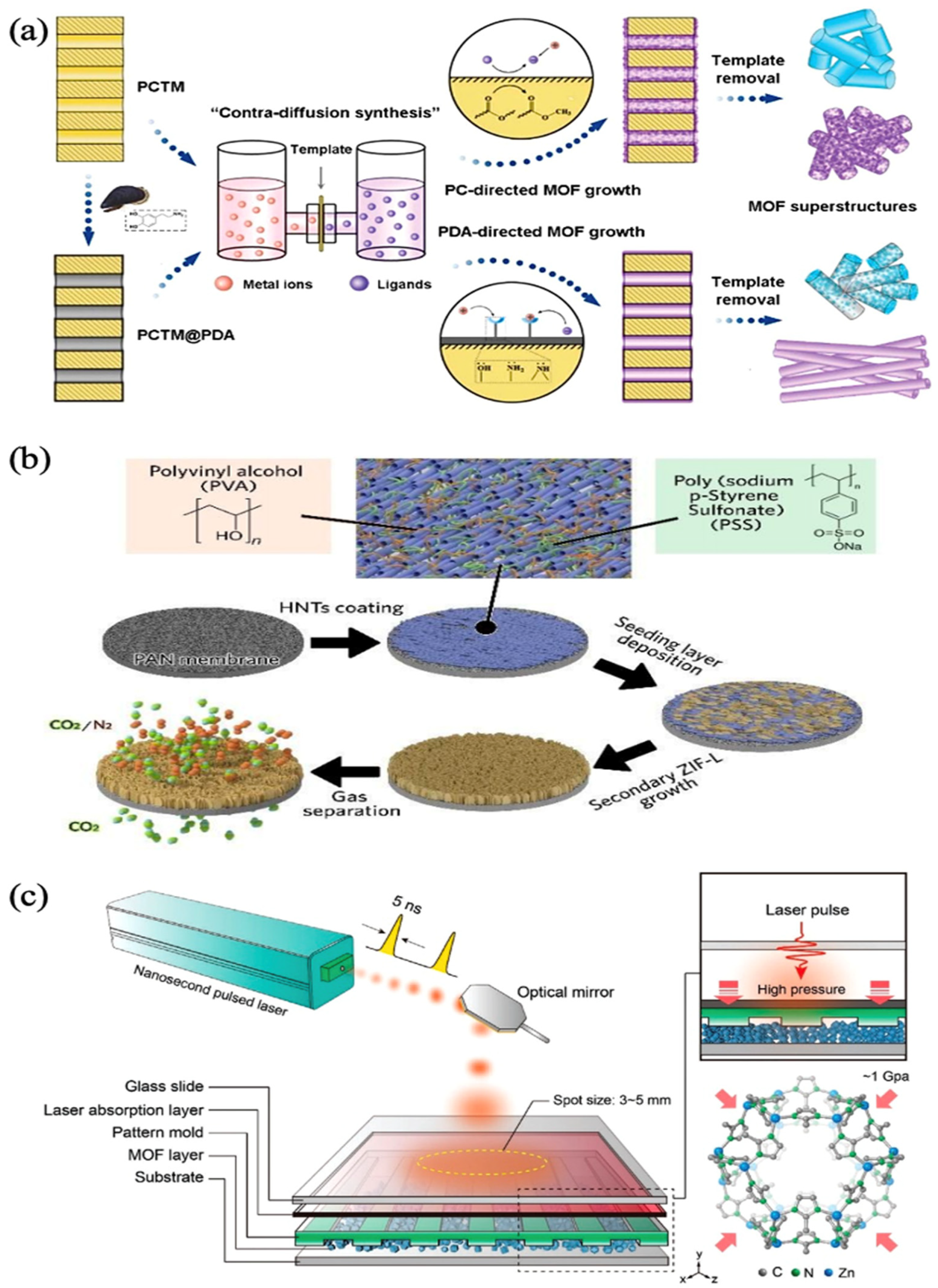
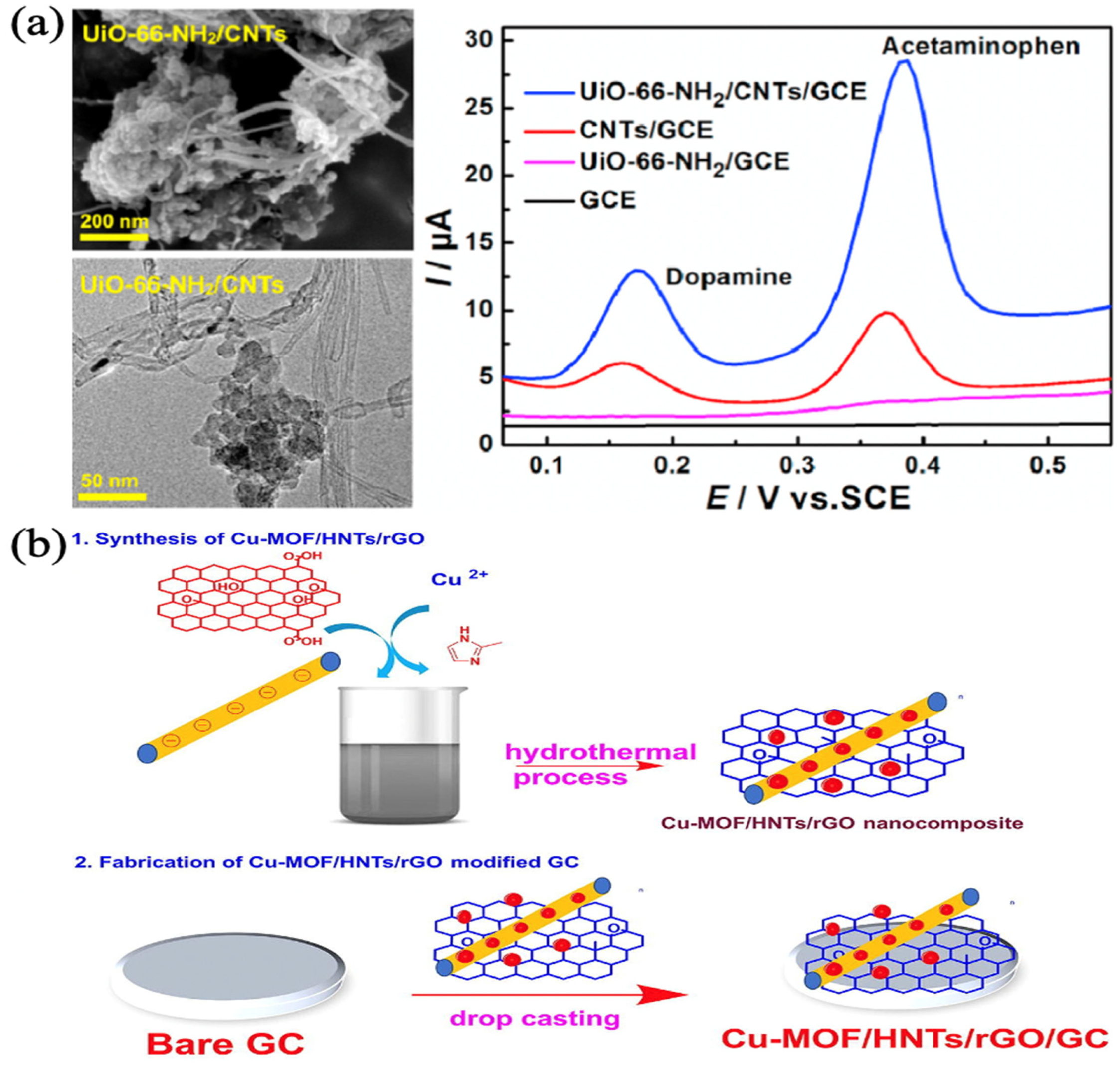
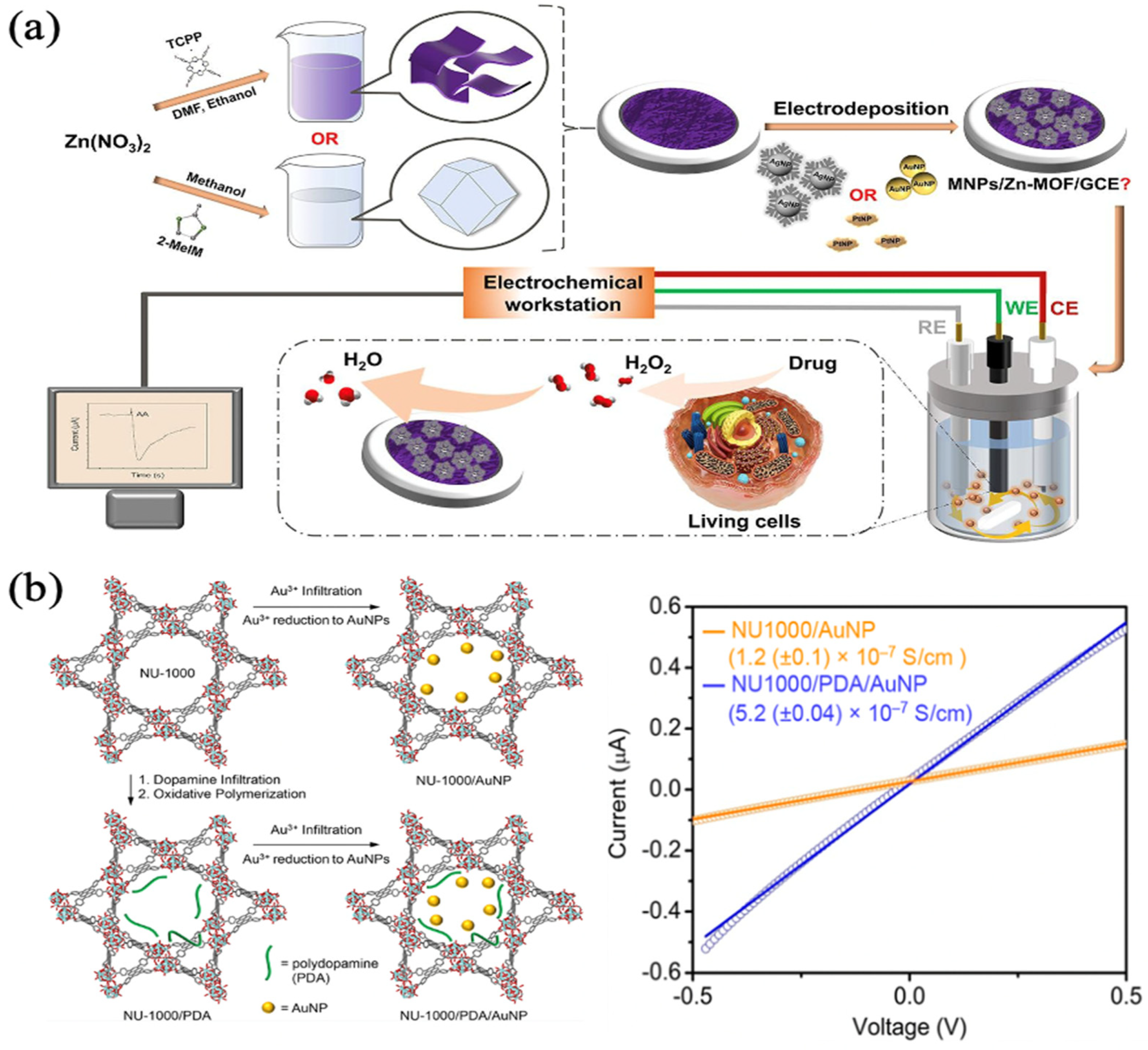
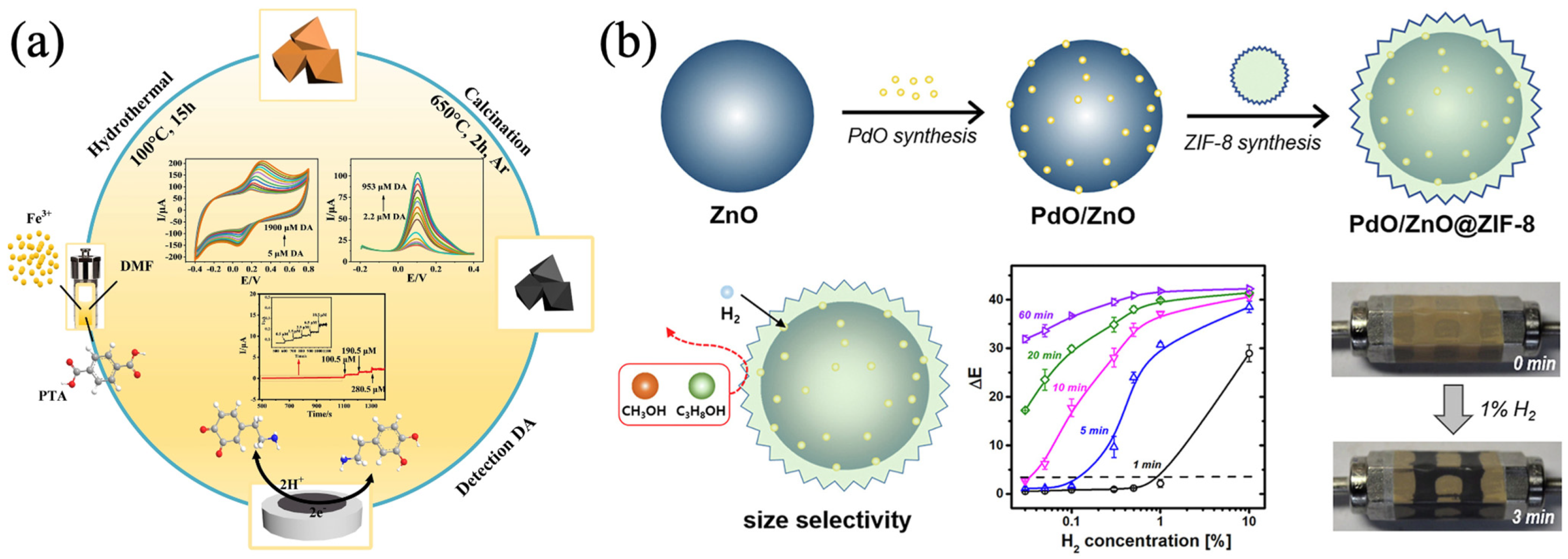
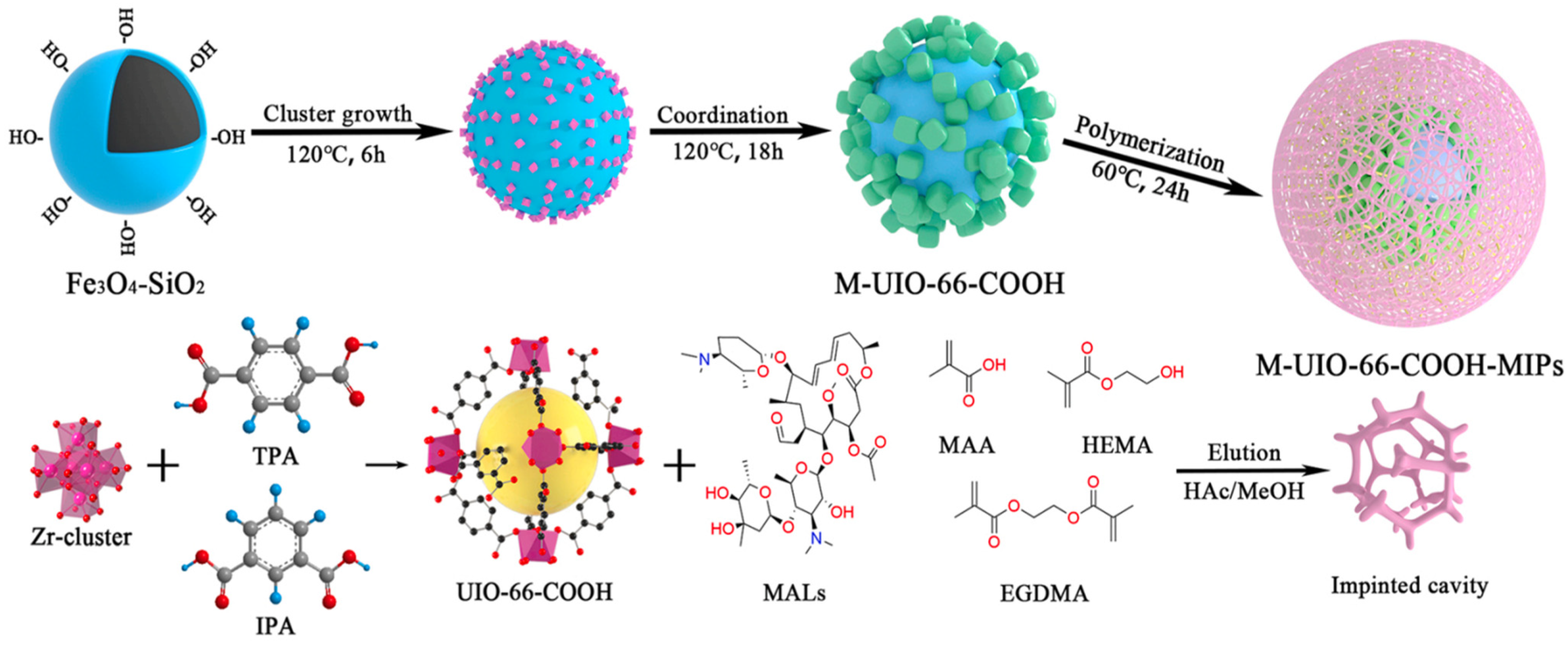
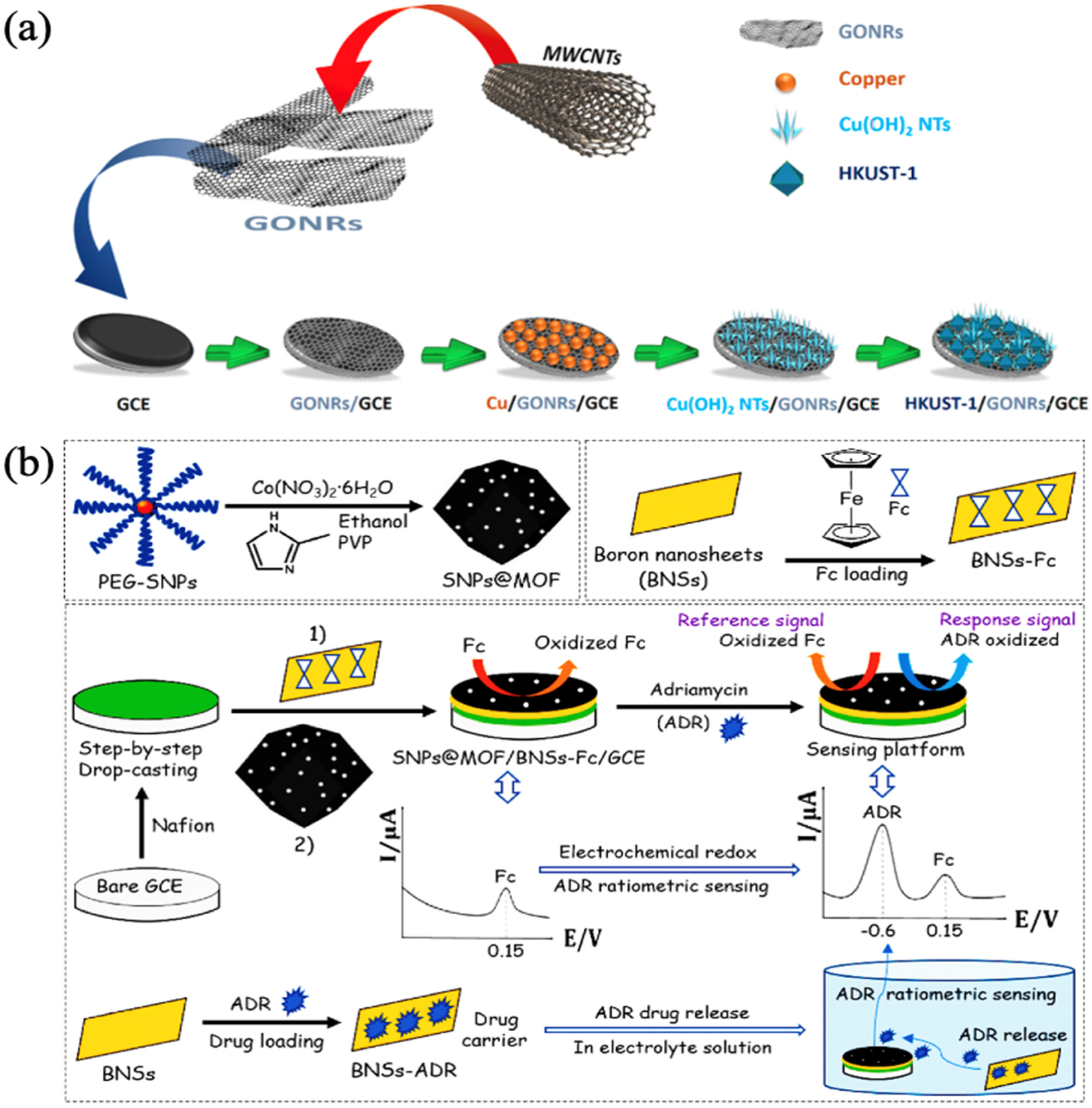
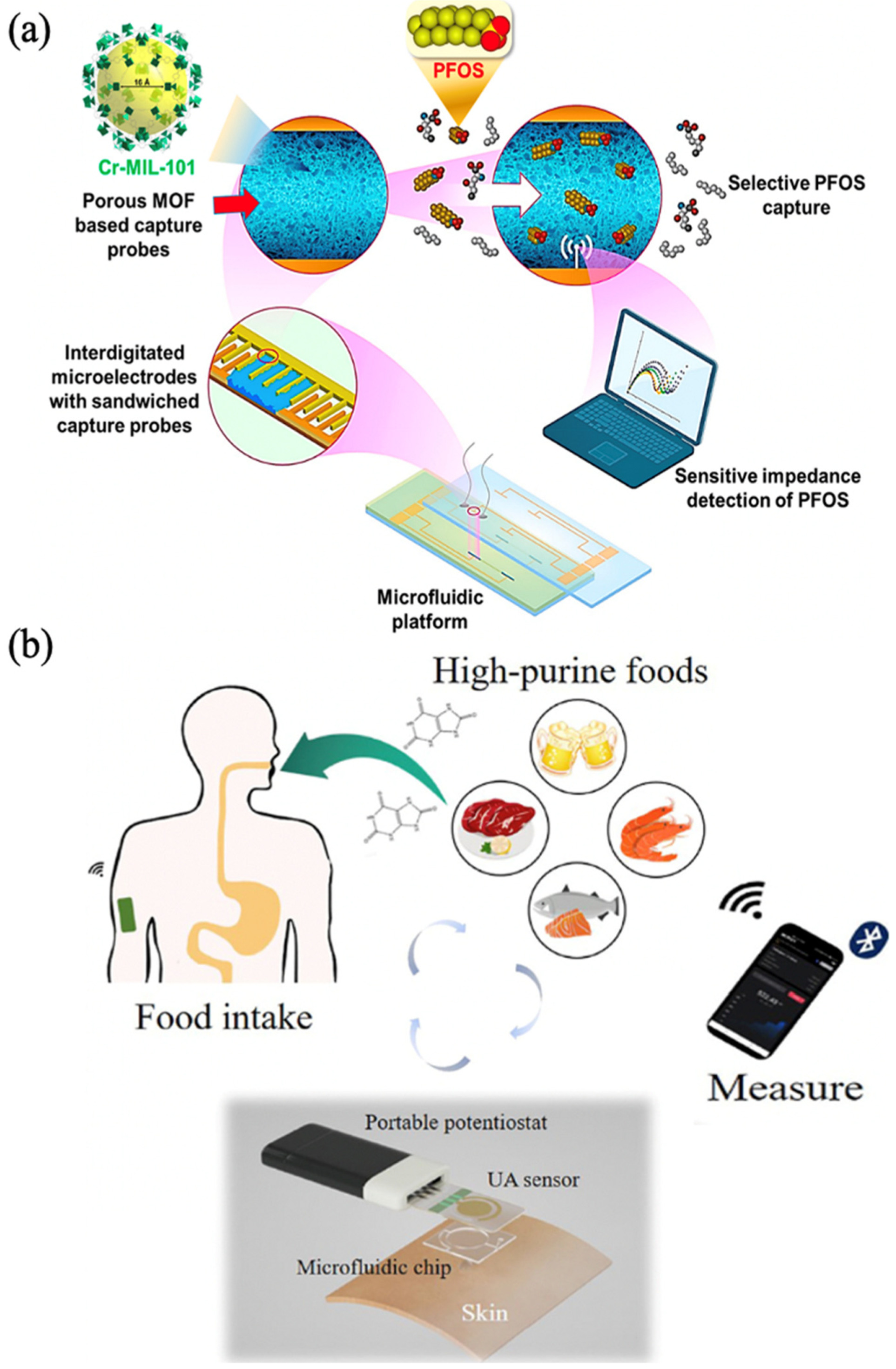
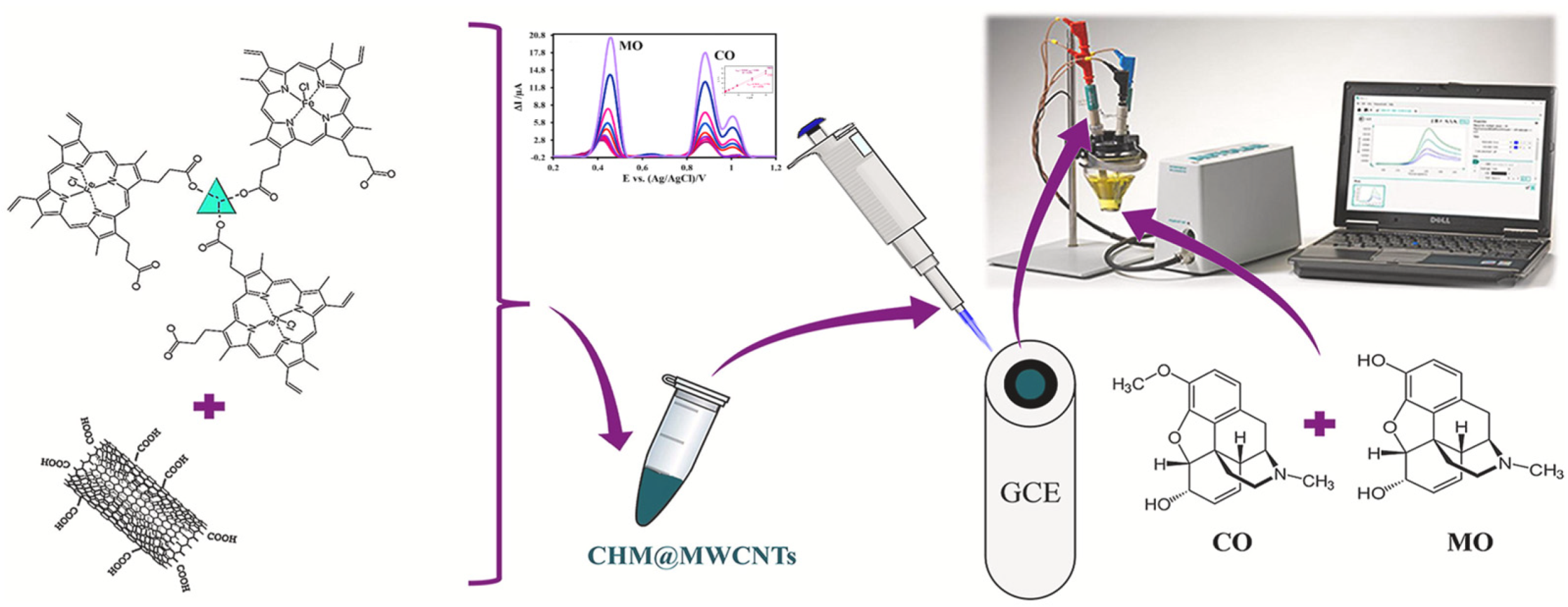
| No. | Classification Method | Common Material |
|---|---|---|
| 1 | Skeleton space composition | One-dimensional (1D) [24,25], Two-dimensional (2D) [26], Three-dimensional (3D) [27] |
| 2 | Ligand | Isoreticular metal-organic frameworks (IRMOFs) [28], Zeolitic imidazolate frameworks (ZIFs) [29], Materials of institut lavoisier (MIL) [30], Porous coordination network (PCN) [31] |
| 3 | Organic bridging ligands | Nitrogen-containing heterocyclic [32], Carboxyl-containing [33], Nitrogen-containing heterocyclic and carboxyl-containing [34] |
| 4 | Composition of materials | Metal-organic framework (MOF-n), Rare-earth polymeric framework (RPF-n) [35], Metal peptide framework (MPF-n) [36] |
| Analyte | Method | Electrode | LOD (μM) | Linear Range (μM) | Real Samples | Ref. |
|---|---|---|---|---|---|---|
| Buprenorphine | CV DPV | Zn/La3+/MOF/MIP/GCE | 0.0021 | 0.0079–0.0992 | Blood | [75] |
| Fentanyl | DPV | Zn (II)-MOF/SPCE | 0.3 | 1–100 | Blood plasma and urine | [76] |
| Fentanyl | DPV | MWCNT-HA/Cu-H3BTC/GCE | 0.003 | 0.01–100 | Blood serum | [77] |
| Methadone Methocarbamol | CV DPV | Cu-MOF/CPE | 0.05 0.02 | 0.08–80; 80–800 0.09–100; 100–900 | Blood and urine | [78] |
| Morphine Codeine | DPV | Cu-hemin MOF@MWCNTs/GCE | 0.0092 0.0112 | 0.09–30 | Urine and injection | [79] |
Disclaimer/Publisher’s Note: The statements, opinions and data contained in all publications are solely those of the individual author(s) and contributor(s) and not of MDPI and/or the editor(s). MDPI and/or the editor(s) disclaim responsibility for any injury to people or property resulting from any ideas, methods, instructions or products referred to in the content. |
© 2023 by the authors. Licensee MDPI, Basel, Switzerland. This article is an open access article distributed under the terms and conditions of the Creative Commons Attribution (CC BY) license (https://creativecommons.org/licenses/by/4.0/).
Share and Cite
Zhao, J.; Kan, Y.; Chen, Z.; Li, H.; Zhang, W. MOFs-Modified Electrochemical Sensors and the Application in the Detection of Opioids. Biosensors 2023, 13, 284. https://doi.org/10.3390/bios13020284
Zhao J, Kan Y, Chen Z, Li H, Zhang W. MOFs-Modified Electrochemical Sensors and the Application in the Detection of Opioids. Biosensors. 2023; 13(2):284. https://doi.org/10.3390/bios13020284
Chicago/Turabian StyleZhao, Jiaqi, Ying Kan, Zhi Chen, Hongmei Li, and Weifei Zhang. 2023. "MOFs-Modified Electrochemical Sensors and the Application in the Detection of Opioids" Biosensors 13, no. 2: 284. https://doi.org/10.3390/bios13020284
APA StyleZhao, J., Kan, Y., Chen, Z., Li, H., & Zhang, W. (2023). MOFs-Modified Electrochemical Sensors and the Application in the Detection of Opioids. Biosensors, 13(2), 284. https://doi.org/10.3390/bios13020284






